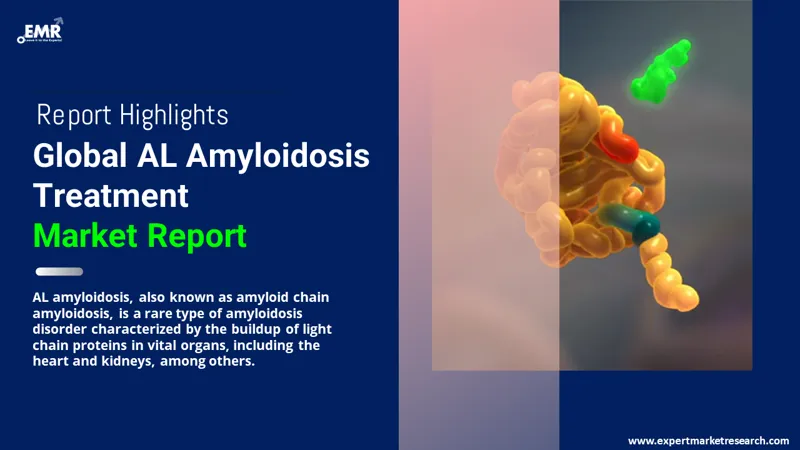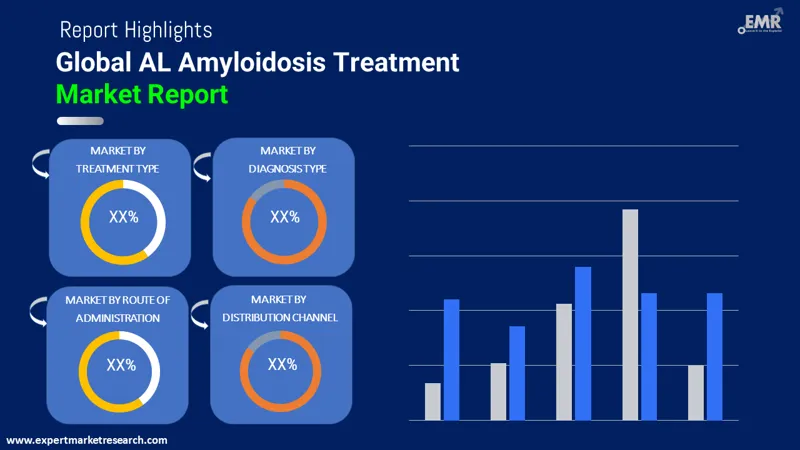
Consumer Insights
Uncover trends and behaviors shaping consumer choices today
Procurement Insights
Optimize your sourcing strategy with key market data
Industry Stats
Stay ahead with the latest trends and market analysis.
The AL amyloidosis treatment market attained a value of USD 4.36 Billion in 2025. The market is likely to grow further at a CAGR of 9.08% during the forecast period of 2026-2035. Within this growth rate, the market value is estimated to reach about USD 10.40 Billion by 2035.
Base Year
Historical Period
Forecast Period
Compound Annual Growth Rate
9.08%
Value in USD Billion
2026-2035
*this image is indicative*
AL amyloidosis or amyloid chain amyloidosis refers to a type of rare disorder amyloidosis. In this disorder, the accumulation of light chain proteins occurs in major organs, such as the heart and kidneys, among other body organs. This type of amyloidosis is also referred to as primary amyloidosis.
AL amyloidosis has a wide range of symptoms as it affects several organs of the body. The symptoms affecting the head and neck include light-headedness, a larger size of tongue, and rashes around the eyes. The clinical manifestations of arms and legs include swelling, burning, numbness, and tingling sensations. The cardiac-associated symptoms are chest pain, shortness of breath, and heart palpitations. Additionally, there are some intestinal and kidney-related problems such as constipation, diarrhoea, bloating, and poor appetite.
Several tests are performed to diagnose AL amyloidosis depending on the organs or systems affected by the disease. Different types of biopsies such as bone marrow biopsy, kidney biopsy, heart biopsy, and fat pad biopsy are commonly used sampling procedures to diagnose AL amyloidosis. Additional tests, such as an echocardiogram, electrocardiogram, cardiac MRI, and other urine and blood tests are used to confirm the presence of AL amyloidosis.
There are multiple treatment strategies for managing AL amyloidosis disease depending on the affected organ and severity of the disease. The commonly used therapeutic interventions are steroids, chemotherapy, immunotherapy, and bone marrow or stem cell transplants.

Read more about this report - REQUEST FREE SAMPLE COPY IN PDF
According to the global AL amyloidosis treatment market research report, the market can be categorised into the following segments:
Market Breakup by Treatment Type
Market Breakup by Diagnosis Type
Market Breakup by Route of Administration
Market Breakup by Distribution Channel
Market Breakup by Region

Read more about this report - REQUEST FREE SAMPLE COPY IN PDF
The market is primarily driven by the increasing prevalence of light-chain amyloidosis. The increased patient pool has led to the growing demand for diagnostics and therapeutics, thus attributing significantly to the market growth. AL amyloidosis affects 5 to 12 in 1000000 people globally. The disease is more prevalent in women as compared to men.
The rising geriatric population in developed and developing nations is also contributing to the increased market growth as this disease is more prevalent in people aged 60 and above.
Further, the AL amyloidosis treatment market is accelerated by the growing research and developmental activities, greater investments by public and private firms. The advancements in healthcare technologies and raising awareness about rare diseases are likely to bolster the market growth during the upcoming years.
The increasing number of collaborations and mergers or acquisitions among the strategic key players are aiding the market growth. For example, AstraZeneca, a key market player acquired Caelum Biosciences in 2021, which is expected to stimulate market expansion. The presence of a robust pipeline of novel targeted therapies for AL amyloidosis is also expected to provide lucrative opportunities for market growth.
North America is anticipated to hold a significant share of the AL amyloidosis treatment market owing to the advanced healthcare facilities, increased healthcare expenditure, and presence of significant key players. The Asia Pacific region is projected to be the fastest growing market due to the improving healthcare systems, rising awareness, and growing geriatric population.
The treatment for AL amyloidosis is highly personalised and individualised depending on the patient’s age, organ dysfunction, and severity of the disease. The treatment regimen is directed based on cardiac and hematologic biomarkers. The therapeutic interventions are based on the symptomatic treatment of the affected organs and systems.
The main aim of the AL amyloidosis treatment is to minimise the plasma cell clone to restore organ functionality. This is achieved by increasing the reabsorption of amyloid and henceforth, improving cardiac productivity rate and patient’s quality of living standards.
The medications used in the management of AL amyloidosis are anti-cancerous drugs or chemotherapy that stop the growth of abnormal cells that form amyloid. Certain types of blood thinners or anticlotting medications, such as Aspirin, are also prescribed to reduce the risk of blood clotting. The targeted therapies, such as Inotersen and Patisiran, interfere with the amyloid-forming faulty genes.
Apart from the medications, certain surgical and transplantation procedures have also been used for the treatment of AL amyloidosis. An autologous blood stem cell transplant is a procedure that involves the retransferring of the body’s stem cells back into the body. Organ transplant is another procedure used to replace organs that are severely damaged by amyloid deposits.
With the high treatment potential, the AL amyloidosis treatment market possesses an excellent opportunity for healthcare industries and pharmaceutical companies in extensive therapeutic methods.
With extensive research and development, new therapeutic interventions are being discovered. There is a need for full-fledged clinical trials before their availability for patient use.
Caelum and Alexion Biosciences, a key market player, is conducting the CARES clinical trials for evaluating the novel targeted therapy in combination with the standard therapy for the management of AL amyloidosis. This therapy has shown promising effects in the elimination of amyloid deposits in patients suffering from AL amyloidosis.
Ixazomib, a proteasome inhibitor, is a new drug tested under the Phase III stage of clinical trials. The drug has shown plausible therapeutic effects in the early phases of the clinical trials and hence, is anticipated to be the potential drug for the treatment of AL amyloidosis.
GlaxoSmithKline has initiated Phase II trials for a new drug, Belantamab Mafodotin, for the management of AL amyloidosis. This drug targets the Fc region of the monoclonal antibodies, to remove the fucose sugar units. This is anticipated to enhance the cell-mediated toxicity.
STI-6129, a new targeted therapy, is under investigation by Sorrento Therapeutics. The drug has demonstrated therapeutic efficacy in animal models and is expected to soon be used as a first-line treatment for treating AL amyloidosis.
These novel targeted therapies seem to grab the attention of key companies and investors, which will directly influence the development of this sector. This will help enable patient access and the growth of the market.
The report gives an in-depth analysis of the key players involved in the AL amyloidosis treatment market, sponsors manufacturing the drugs, and putting them through trials to get FDA approvals. The companies included in the market are as follows:




*While we strive to always give you current and accurate information, the numbers depicted on the website are indicative and may differ from the actual numbers in the main report. At Expert Market Research, we aim to bring you the latest insights and trends in the market. Using our analyses and forecasts, stakeholders can understand the market dynamics, navigate challenges, and capitalize on opportunities to make data-driven strategic decisions.*
Get in touch with us for a customized solution tailored to your unique requirements and save upto 35%!
The market size reached a value of USD 4.36 Billion in 2025, driven by the rising prevalence of the condition.
The market is estimated to grow at a rate of 9.08% during the forecast period of 2026-2035 to attain a value of USD 10.40 Billion by 2035.
The market growth is primarily driven by the rising cases of AL amyloidosis, the rising geriatric population, increasing research and development activities, and a robust pipeline of therapeutic products.
Based on the treatment type, the market is categorised into corticosteroids, proteasome inhibitors, cytotoxic chemotherapy, immunomodulatory drugs, autologous hematopoietic stem cell transplantation, risk-adapted melphalan, among others.
Based on the diagnosis, the market is segmented into blood tests, magnetic resonance imaging (MRI), ultrasound, and biopsy, among others.
Based on the route of administration, the market is bifurcated into oral and injectables, among others.
Based on the distribution channel, the market is divided into hospital pharmacies, retail pharmacies, and online pharmacies.
The different regions in the market are North America, Europe, Asia Pacific, Latin America, the Middle East and Africa. North America is anticipated to hold a significant share of the market during the forecast period.
The key companies involved in the market are Janssen Global Services, LLC, Caelum Biosciences (AstraZeneca), Oncopeptides, Inc., Bristol-Myers Squibb Company, Acrotech Biopharma, Inc., Sanofi, Prothena Corporation plc, Alexion Pharmaceuticals, Inc., Takeda Pharmaceutical Company Limited, GSK plc, and Sorrento Therapeutics, Inc., among others.
Explore our key highlights of the report and gain a concise overview of key findings, trends, and actionable insights that will empower your strategic decisions.
| REPORT FEATURES | DETAILS |
| Base Year | 2025 |
| Historical Period | 2019-2025 |
| Forecast Period | 2026-2035 |
| Scope of the Report |
Historical and Forecast Trends, Industry Drivers and Constraints, Historical and Forecast Market Analysis by Segment:
|
| Breakup by Treatment Type |
|
| Breakup by Diagnosis Type |
|
| Breakup by Route of Administration |
|
| Breakup by Distribution Channel |
|
| Breakup by Region |
|
| Market Dynamics |
|
| Supplier Landscape |
|
| Companies Covered |
|
Datasheet
One User
USD 3,299
USD 2,969
tax inclusive*
Single User License
One User
USD 5,499
USD 4,949
tax inclusive*
Five User License
Five User
USD 6,999
USD 5,949
tax inclusive*
Corporate License
Unlimited Users
USD 8,199
USD 6,969
tax inclusive*
*Please note that the prices mentioned below are starting prices for each bundle type. Kindly contact our team for further details.*
Flash Bundle
Small Business Bundle
Growth Bundle
Enterprise Bundle
*Please note that the prices mentioned below are starting prices for each bundle type. Kindly contact our team for further details.*
Flash Bundle
Number of Reports: 3
20%
tax inclusive*
Small Business Bundle
Number of Reports: 5
25%
tax inclusive*
Growth Bundle
Number of Reports: 8
30%
tax inclusive*
Enterprise Bundle
Number of Reports: 10
35%
tax inclusive*
How To Order

Select License Type
Choose the right license for your needs and access rights.

Click on ‘Buy Now’
Add the report to your cart with one click and proceed to register.

Select Mode of Payment
Choose a payment option for a secure checkout. You will be redirected accordingly.
Gain insights to stay ahead and seize opportunities.

Get insights & trends for a competitive edge.

Track prices with detailed trend reports.

Analyse trade data for supply chain insights.

Leverage cost reports for smart savings

Enhance supply chain with partnerships.

Connect For More Information
Our expert team of analysts will offer full support and resolve any queries regarding the report, before and after the purchase.
Our expert team of analysts will offer full support and resolve any queries regarding the report, before and after the purchase.
We employ meticulous research methods, blending advanced analytics and expert insights to deliver accurate, actionable industry intelligence, staying ahead of competitors.
Our skilled analysts offer unparalleled competitive advantage with detailed insights on current and emerging markets, ensuring your strategic edge.
We offer an in-depth yet simplified presentation of industry insights and analysis to meet your specific requirements effectively.
Share